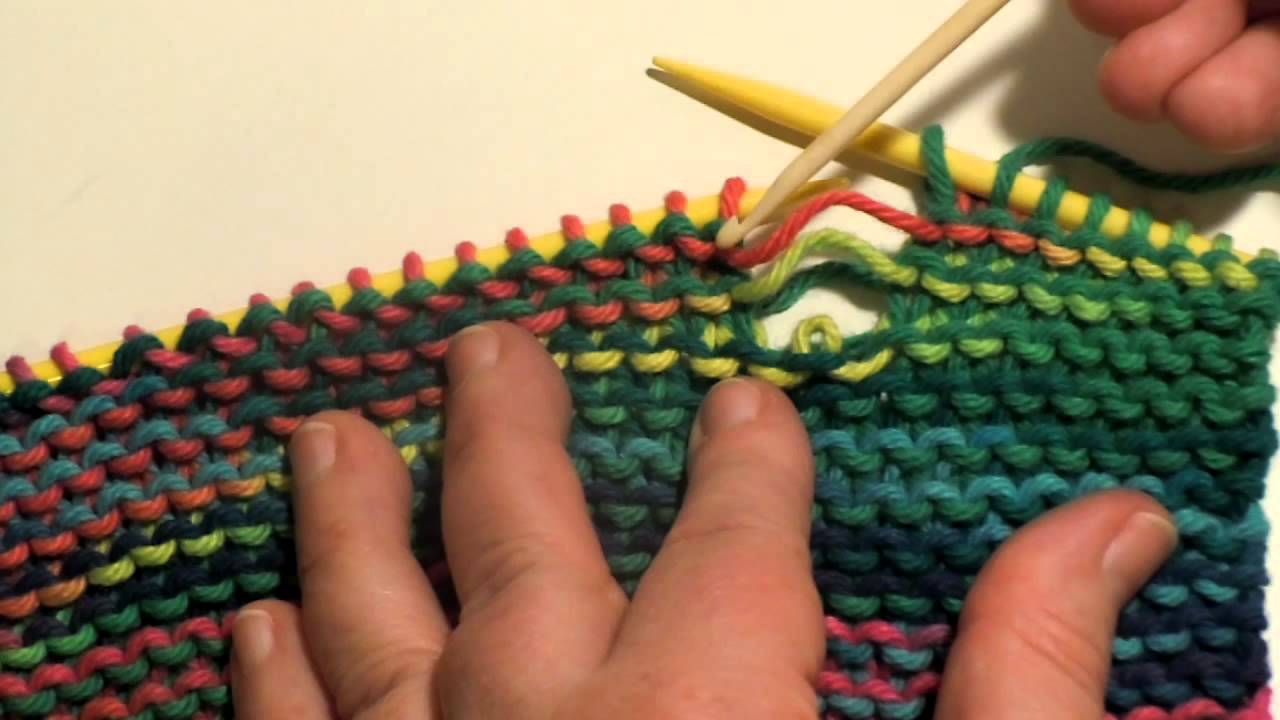
Using the KFB (Knitter's Front Loop) is the best way to create a double stitch, and it's a good idea to have a quick refresher before you begin your next project. It's a clever way to create three stitches out of one, but it's not always easy to do. You will need to practice a bit of needle acrobatics and it may take a few attempts before you become proficient. Here are a few tips to help you get started.
First, a circular needle is best. This will allow you to fit multiple stitches on the needle. The yarn doesn't need to be joined. If you don't want to join, you can just slip the first stitch onto the right needle while knitting the rest of the row. This is an excellent trick for tight knitters. This trick involves keeping 2 stitches between each stitch you are knitting and slipping the next one.
Next, you will need to figure out how to get the best use of the foundation stitches. The front of the foundation stitch is a half green and half blue color. It's important to know that this stitch has two parts, a twisted top portion and an untwisted bottom portion. Slip the first stitch purlwise and knit the rest of your row. This may sound like a pain to do, but it's actually quite easy.

The next step is to find a way that the M1 or horizontal bar can increase. This is an easy way to add one more stitch to a row. But, be careful about not slipping it off the needle. It's a small trick, but it's the small stuff that makes the biggest difference.
Next, you will need to figure out a clever method to increase the M2 (horizontal bars) and M1 (increase). Unlike the previous trick, this one involves knitting two stitches in the same foundation stitch. Although it isn't as impressive as the M1 Increase, it is a great way to get started.
The KFB (Knitter’s front loop), is the most exciting of all stitches. This trick can be used to create a double-stitch, but you can also use it for an M1 increment. This trick requires some acrobatics, but you'll have a blast knitting.
This technique doesn't require complicated rows or yarnovers. This method is also much easier on your wallet. This method requires you to only purchase a few yards of yarn. If you go the traditional route, you will have to pay for much more yarn.

It's important to not let the knit stitch slide off the needle. But the KFB is an innovative way to create a beautiful stitch that's just as useful as it looks.
FAQ
Where can I get free resources to learn more?
Many websites are dedicated to helping people find new hobbies.
Here are some of our favorite:
www.trythisathome.com - This site provides a list of over 100 different hobbies. You can also find information about how to start each hobby.
www.hobbyfinders.org -- This site provides a searchable database of thousands upon thousands of hobbies that you can browse by skill level, location and interest.
www.indiebazaar.co.uk - IndieBazaar is an online marketplace designed specifically for independent artists and musicians. You will find hundreds of products that range from artwork to music gear on the site.
www.pinterest.com/explore/hobbies - Pinterest is a social media network that lets users "pin" images they find interesting onto their boards. Users can organize the things they like in specific categories with boards.
www.reddit.com/r/Hobbies Reddit allows users to share links to articles, videos and other content on their social media platforms. Voting allows users to vote for the most valuable posts.
What are educational hobbies?
An educational hobby can be defined as an activity in which you learn something through doing it. This could include anything from learning to play an instrument to playing sports.
The most important thing is that you find it enjoyable and entertaining. It doesn't have to be done all the time. However, if you get bored of it, you should think about other things you can do instead.
You should also make sure that you are not spending too much money on these activities. It could end up costing your more than it's worth.
What are some great hobbies?
Doing something you enjoy is the best hobby. You will find it easier to stay motivated if you love what your doing. If you don't feel well or tired, you will always have an excuse!
Our hobbies include painting, crafts, photography and cooking.
You could also consider volunteering at a local charity shop, animal shelter, children's hospital, hospice, elderly care home, school, community center, church, etc.
Let's say you are looking for something more exciting. Why not take up scuba diving, rock climbing, sky diving, bungee jumping, white water rafting, sailing, surfing, canoeing, kayaking, horse riding, zip lining, hang gliding, paragliding, skydiving, snowboarding, skiing, mountain biking, hiking, camping, fishing, hunting, archery, shooting, clay pigeon shooting, target shooting, golf, tennis, swimming, snorkeling, windsurfing, waterskiing, kitesurfing, wakeboarding, standup paddle boarding, hang gliding, parasailing, hot air ballooning, paragliding and many more.
There are many unique ways to spend time in the outdoors, whether you're looking for adventure or a more traditional way to do it. These include caving.
What are good hobbies for seniors?
Senior citizens should find activities they love to do. They should also try to stay active by participating in sports and other physical activities.
They may wish to join clubs, where they can find others who have similar interests. As they age, this will help them feel less alone.
Senior citizens should keep up to date with the latest trends. You could, for example, follow the latest trends in fashion, literature, and music.
How do I find a hobby to pursue?
It can feel overwhelming to start your search for a hobby when you first begin.
You're likely thinking, "I can't be very artistic" or "I have no idea what I'm doing."
There is a good chance that you have some experience with hobbies.
It's just that you haven't realized it yet.
Have a look at your home. How much stuff are you able to store?
Are there any toys that you don't use anymore?
Maybe you have a collection of books or magazines.
Perhaps you've always wanted a career in cooking.
Or perhaps you would just like to learn how to play the guitar again.
Whatever it may be, you can likely turn it into something.
Realize that you have many experiences already.
You will find a hobby you love once you have it.
Statistics
- 37% Video Games 36% Travel 36% Health and Fitness (quizexpo.com)
- In comparison, men in the “no humor” condition were refused 84.6% of the time and were only accepted 15.4% of the time. (time.com)
- The intensity of the dialogue partners' bond at the end of the forty-five-minute vulnerability interaction was rated as closer than the closest relationship in the lives of 30 percent of similar students. (time.com)
- I am 100% biologically a woman (discover.hubpages.com)
- The Role of the Mind in Sex, Dating, and Love: Men in the “humor” condition received phone numbers from 42.9% of the female participants and were refused 57.1% of the time. (time.com)
External Links
How To
How to Start Gardening
Gardening is one of the oldest forms of agriculture. It requires patience, persistence, and determination. The first step in starting your own garden is choosing a location where you want to grow food. You could choose to plant food on a large parcel of land, or in your own backyard. Next, decide what type of plants you want to grow. Do you prefer flowers over vegetables? Some people enjoy growing herbs while others love raising livestock such as rabbits. Before you decide on the type of crops you want to plant, it is important to consider the space available. If you live in a climate that experiences cold winters, then you might decide to grow fruits or berries as they do well in colder climates.
Once you have selected the plants you wish to plant, you should prepare your soil. Your plants' success or failure will depend on the soil they are placed in. Good quality soil contains organic matter that helps feed your plants' roots. Organic matter includes organic matter such as leaves, twigs or grass clippings. Once you have prepared your soil, you need to add nutrients. You might need different amounts, depending on the species of plants that you want to grow. An online fertilizer calculator can help you calculate these values. There are many fertilizers on the market, so ensure you understand what you are buying.
After you have prepared your soil, and added the correct nutrients, you will need to wait until your seed germinates. The process takes between 2 weeks and 3 months depending upon the climate in your area. Once your seeds are sprouted, you must water them regularly. Overwatering your plants can lead to problems. Avoid overwatering your plants. Overwatering can result in root rot, fungal diseases, and even death. Remember that plants need less water in the summer than they do in the winter. Remember that some plants require drying out after being watered. For example, tomatoes need to stay slightly moist but not wet. They are not happy to be in soggy soil. After the flowers have stopped, they must go into dormancy. Plants go dormant when they stop producing new growth and instead store energy for next year's harvest. The plant ceases sending signals to its roots to produce food during dormancy. Throughout this time, plants can store energy. However, the plant will die if temperatures drop below freezing or there is insufficient sunlight.
Living in urban areas may restrict the types of plants you can plant. Urban areas tend to contain concrete sidewalks, roads, buildings, and parking lots that block sunlight from reaching the ground. Concrete absorbs light and prevents soil below from getting sufficient sun exposure. Many plants can't survive in urban environments due to lack of sunlight. Many plants can still thrive in urban settings. Many perennials, trees, and shrubs are able to adapt to urban living. In addition, many annuals can be grown indoors in containers. Container gardens allow you to bring fresh greenery into your home year-round regardless of the weather outside.
You are now ready to plant your garden!